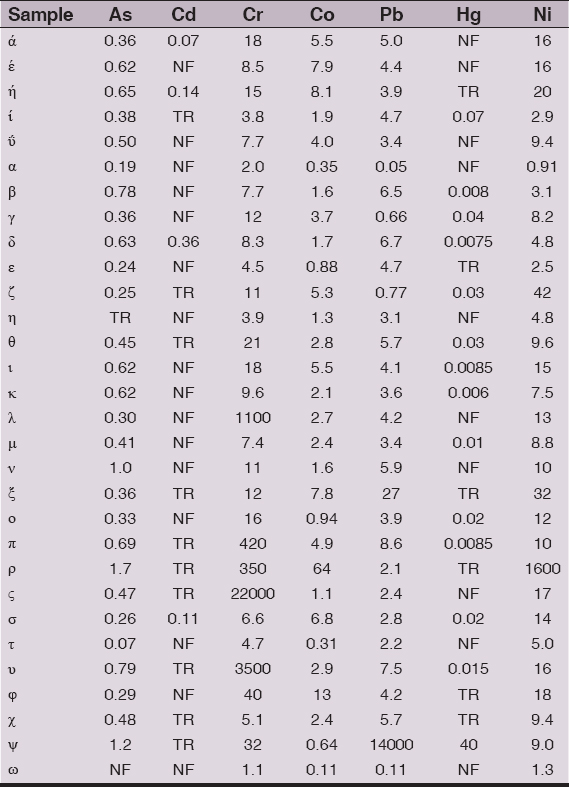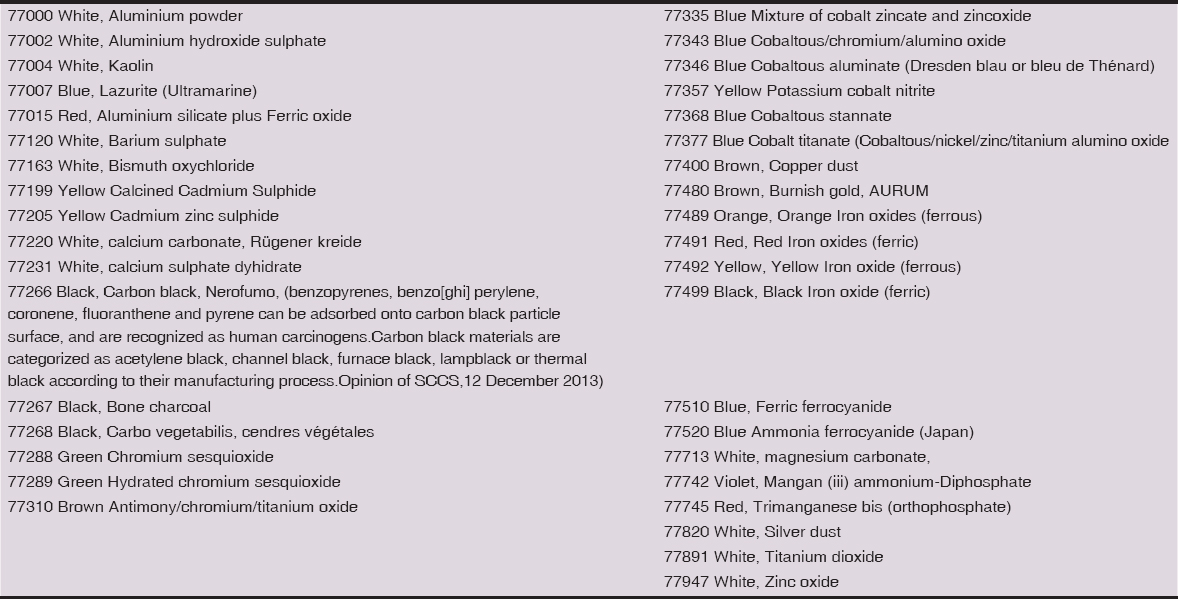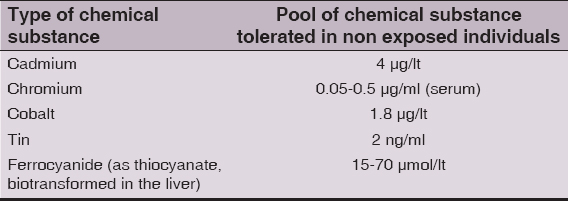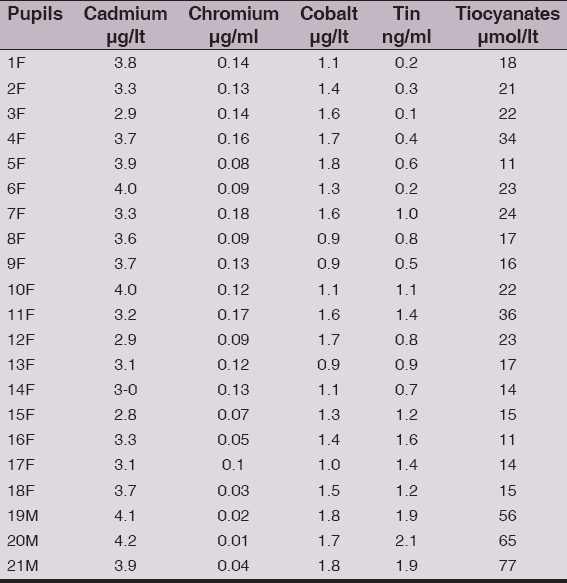The fascination of mineral pigments in organic and natural eye shadows and compact cakes: are they risky or innocuous?
Lorenzo Martini
University of Siena, Department of Pharmaceutical Biotechnologies, Via A.Moro 2, 53100 Siena, Italy
INTRODUCTION
A recent study conducted at the Ahmadu Bello University of Zaria, Nigeria [1] refers that different samples of made in China eye shadows randomly selected from products available in the shops at several towns of Nigeria, were analysed to determine the levels of heavy metals (Pb, Cd, Ni, Cu, Zn, Cr, Co, and Mn).
Moreover an avalanche of experiments conducted all over the world have been showing since immemorial times that a plentitude of decorative make up products for eyes that had been examined contained huge amounts of hazardous heavy metals [2].
Here follows Table 1 where the results of these analysis are referred [2].
Purpose of my research, indeed, is to determine the levels of certain minerals that are usually included (because legally admitted) in the formulas of eye shadows, kohls and encaustics (crayons) which are retrievable in human blood after application onto eyelids, eyelashes and eyebrows of the aforesaid decorative products.
I intend to discover the pool of heavy minerals and other chemical constituents that are reputed dangerous for Human health in volunteers’ blood, even though my attention is not focused on the accidental presence of heavy metals, but actually on the same metals that are admitted in the Strasbourg’s International Nomenclature Cosmetics Index, and therefore are designed as inorganic pigments.
All the inorganic pigments useful to decorate eyes belong to the category of colours (designed as Colour Index, whereof the acronym is C.I.) that is comprised between the progressive number 77000 and 77999, throughout the entire world, unless only a minor part of those is allowed by EC and is referred below, quite completely (Box 1):
We want to stress that pigments, with relative C.I. number, written in bold italics are those that are to be reputed toxic and risky, even though I have recorded even the pigment C.I. 77520, that is extremely carcinogenic, that is fully admitted in Japan and in many other countries and consequently eye decorative products containing it are globally retrievable in the markets and boutiques of all the world.
MATERIALS AND METHODS
In order to determine how the matrix of excipients and bulking agents can be reputed responsible of the release of the same heavy metallic ions, I have chosen three different formulas of eye shadows, (designed as pressed powders or compacts or cakes) which contain diverse inert powders, starch, a natural binder and the mineral pigments.
The first of those is considered a fully “classic and chemical fard aux paupières” and the other two are designed as “organic and natural metallic compact powdered cakes”.
It is suggestive to emphasize that starch and the natural binder, that is the caprylic/capric glycerides, appear always in all the three formulations, that the pigments are always the same but only two ingredients, corresponding to the inert powders, change in the formulas and exactly these are supposed to interfere with the same release, since they can behave as linkers and sequestrers of the metallic ions.
Formula num ONE:
- Talc
- Zinc stearate
- Zea mays starch
- Caprylic/capric glycerides
Formula num TWO:
- Shellac
- Calcium Magnesium silicate
- Zea mays starch
- Caprylic/capric glycerides.
Formula num THREE:
- Karaya gum
- Magnesium carbonate
- Zea mays starch
- Caprylic/capric glycerides
The following is the list of the pigments I have employed to give four compact eye shadows blue with golden sparkling and fluorescent reflections:
- Cadmium zinc sulphide
- Chromium sesquioxide
- Cobaltous aluminate (Dresden blau or bleu de Thénard)
- Cobaltous stannate
- Ammonia ferrocyanide
The total amount of the powdered pigments represents the 7.00% in each formula;the remnant is constituted by inert powders, bulking agents and the binder.
We have a class of galenic preparations laboratory and the class numbers 21 pupils, 18 of whom are female and the other 3 are male.
Even the boys do not distaste to wear eye shadow when go out to dance on Saturday night and so it has been easy to let them prepare the three formulas and pray them to decorate their own eyelids by the aids of three simple sponge-tipped plastic rods (in order not to inquinate the different products) and to undergo two mineralogram blood tests, the former before and the latter after the application of the cosmetic products onto their eyelids.
It is well known that skin penetration of whichever chemical substance is performed through the conjunctival sac and through the stratum corneum of the eyelid itself, that is the thinnest epidermal layer in all the human body.
Since these toxic substances are often ingested or inhaled accidentally a list of tolerable limits of their presence in blood exists and is to be considered official; and therefore is plotted in Table II:
The three types of coloured cakes (pressed powders) were prepared during the class of laboratory preparations and were shared in 63 small tureens, and each of every pupil had three tureens available, to spread onto his own eyelids in three different occasions, during the Carnival feasts and precisely on Thursday, on Sunday and next Tuesday night (Jeudi Gras, Samedi Gras and Mardi Gras).
The successive morning of every night of amusement, at 7.00 a.m., before classes, the pupils were invited to have their blood examined to detect the plot of heavy minerals and tiocyanates.
Here follow Tables III and IV where all the scores regarding the classic and chemical “compact fard aux paupières” and regarding the organic and natural compacts cakes are reported:
DISCUSSIONS
It is evident that formula num ONE that contains Talc and Zinc stearate, as prime bulking agent and excipient, releases substantially the metallic ions and the ferrocyanides, cause of their intrinsic chemical structure, being inert powders, that is that are not prone to sequestrate the ions, as no free electric charges are available on their molecules.
Therefore high levels of Cadmium, Chromium, Cobalt, tin and ferrocyanide (as tiocyanates) are present in the blood of volunteers that applied this chemical formula of pressed powder.
On the other hand, the natural cakes can boast about the presence of gum resins and bioplymers as shellac and/or karaya gum.
Shellac, a resin secreted by the female lac bug, on trees in the forests of India and Thailand, according to manifold A.A. [3–7]. contains polyhydroxy acids and it has been suggested that these might occur as lactides or as other inter-esters‘ in producing the resin., giving its peculiar liquid-viscous texture, with the capability of linking bivalent and polyvalent metallic ions.
Karaya gum, instead, is a vegetable gum produced as an exudate by trees of the genus Sterculia. Chemically, gum karaya is an acid polysaccharide composed of galactose, rhamnose and galacturonic acid, so that the carboxylate ions are capable to capture and sequester the risky ions and ferrocyanides.
It is suggestive to observe that as far as tiocyanates levels (derived from the biotransformation of ferrocyanides in liver and detectable in human plasma) are higher in man than in female, and several are the A.A. which have attempted to clarify this obscure phenomenon [8,9].
Finally, male can more easily intoxicated by Cobalt and Tin, and this matter of fact is utterly unclear.
REFERENCES
1. Omolaoye JA, Uzairu A, Gimba CE, Heavy metal assessment of some eye shadow products imported into Nigeria from China: Scholars Research LibraryArch Applied Science Research 2010; 2: 76-84.
2. Hepp NM, Mindak WR, Gasper JW, Thompson CB, Barrows JN, Survey of cosmetics for arsenic, cadmium, chromium,cobalt, lead, mercury, and nickel contentJ Cosmet Sci 2014; 65: 125-45.
3. Bhattaoharya R, J Sac Chem Ind 1935; 54: 82.
4. Gardner WH, Shellac Research Bur., 1928: Polytech. InstBrooklyn Reports
5. Harries C, Nagel W, Ber1922; 55: 3833.
6. Jamieson GS, Am J Sci1912; 4: 33.
7. Schaeffer BB, Gardner WH, Ind Eng Chem1938; 30: 333.
8. El Hadri L, Chanas B, Ghanayem BI, Comparative metabolism of methacrylonitrile and acrylonitrile to cyanide using cytochrome P4502E1 and microsomal epoxide hydrolase-null miceToxicol Appl Pharmacol 2005; 205: 116-25.
9. Kouichiro T, Mieko K, Yasuo S, Cyanide and Thiocyanate Levels in Blood and Saliva of Healthy Adult VolunteersJ Health Science 2000; 46: 343-50.
Notes
Source of Support: Nil,
Conflict of Interest: None declared.





Comments are closed.